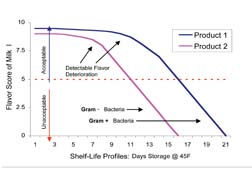Shelf Life: The Ultimate Quality Test
Q: What is the ultimate measure of product quality?
A: Shelf Life a.k.a. Keeping Quality.The shelf life of a food is the length of time that a product is acceptable and meets consumer quality expectations. However, since the quality of most foods decreases over time, there is a need to evaluate how long products will maintain commercial value. Shelf-life testing measures of the quality factors that define the food and the point at which failure occurs.
Shelf-life testing can be difficult, daunting, and expensive. But here are some basics to maintaining shelf life that can make a quality program successful.
Causes of Spoilage: The primary cause of spoilage of high temperature short time (HTST)-processed products is the growth of spoilage bacteria. Psychrotrophic bacteria (capable of fairly rapid growth at refrigerated temperatures) account for a majority of the typical spoilage problems, but slower-growing, heat-resistant Bacillus and Micrococcus species may be significant contributors to spoilage as code dates are extended. Spoilage also may be caused by heat-resistant bacterial proteases. Thus, high-quality raw milk is a basic requirement for achieving shelf-life goals.
Shelf Life Defined: This is the length of time between processing/packaging that the product maintains its freshness and consumer acceptance. Unfortunately, there is no reliable quantitative procedure for determining predicted or actual shelf life. It is determined by our customers on a daily basis-by taste. Since our customers perform the test, it makes sense that the Ultimate Quality Test should be an integral part of our Quality Assurance program.
Determining Shelf Life: There is a difference between loss of freshness/ consumer acceptance and actual spoilage. I would define loss of freshness as being at the point when the product is not as good as when it was first processed/packaged. Spoilage, on the other hand, would be defined as when the product has developed off-flavors of sufficient intensity to be rejected by consumers-simply not consumable. Of course, the off-flavor threshold level of intensity may vary with individual consumers, but rest assured that as flavor quality deteriorates during storage, acceptability and consumption will decline, even though the customer may not complain about spoilage.
Basic Fact: HTST-processed dairy products do not go from having excellent flavor today to being spoiled tomorrow. It is a gradual and often subtle process (see graph).

Requirements for Shelf-Life Testing
The following elements are essential to testing shelf life:- Dedicated individuals who have been trained in performing critical sensory taste tests;
- Shelf-Life Box (preferably walk-in) capable of maintaining a constant temperature of 45
Looking for a reprint of this article?
From high-res PDFs to custom plaques, order your copy today!






